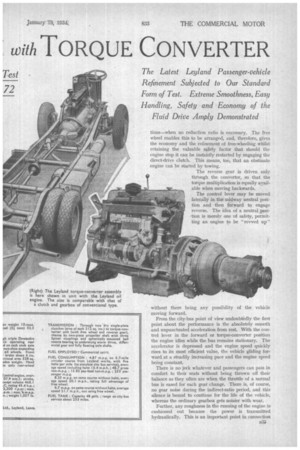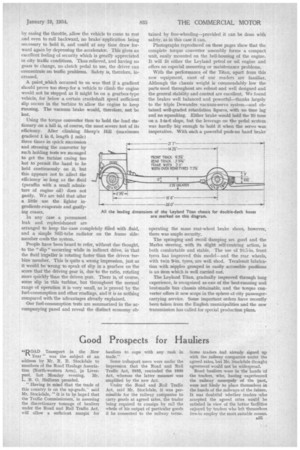TESTING a LEYLAND TITA with TORQUE CONVERTER The Latest Leyland
Page 42

Page 43

Page 44

Page 45

If you've noticed an error in this article please click here to report it so we can fix it.
Passenger-vehicle Refinement Subjected to Our Standard Form of Test. Extreme Smoothness, Easy Handling, Safety and Economy of the
Fluid Drive Amply Demonstrated
HYDRAULIC transmission has long attracted designers by its promise of a smoothness of drive which would make a revolutionary improvement in the comfort and ease of control of the city bus, the frequent stopping and starting of which is the outstanding feature of its work. One of the first turbine systems to be offered as standard equipment is that now available optionally on Leyland buses; it was illustrated and explained in this journal dated October 13 last and was exhibited at the Olympia Show a few weeks later.
We have now been able to follow, up our brief road experience of last autumn by subjecting a Titan doubledeck bus chassis with the torque converter to our standard form of road test, and can wholeheartedly endorse the performance impressions which we first formed. A quite uncanny smoothness of drive is obtained and this is accompanied by several distinct practical advantages which together make the new transmission very attractive to the municipal or commercial operator of city buses.
Our test was made in Lancashire last week with a production chassis loaded to the legal limit of 10 tons for a fully laden double-decker. The chassis and engine were certainly too new to give their best performance, having had only the preliminary trial run on the road, but the results obtained in figures support in a striking way the opinion formed from driving the machine.
It is not intended to repeat the full description already published of the Lysholm Smith system. It will be recalled that the unit consists of a double-acting clutch . (for connecting the engine either to the torque converter or direct to the propeller shaft), a three-stage turbine, a free wheel and a one-to-one reverse gear. The turbine will multiply the torque put into it by, at the most, 4.8. B32 The drive could at all times be taken through this converter, but the addition of a direct mechanical drive permits the whole hydraulic mechanism to remain at rest all the while the vehicle is cruising along in "top-gear" condi
tions—when no reduction ratio is necessary. The free wheel enables this to be arranged., and, therefore, gives the economy and the refinement of free-wheeling whilst retaining the valta.ble safety factor that should the engine stop it can be instantly restarted by engaging the direct-drive clutch, This means, too, that an obstinate engine can be started by towing.
The reverse gear is driven only through the converter, so that the torque multiplication is equally available when moving backwards.
The control .lever may be moved laterally in the midway neutral position and then forward to engage reverse. The idea of a neutral position is merely one of safety, permitting an engine to be "revved up" without there being any possibility of the vehicle moving forward.
From the city-bus point of view undoubtedly the first point about the performance is the absolutely smooth and unpunctuated acceleration from rest. With the control lever in the forward or torque-converter position the engine idles while the bus remains stationary. The accelerator is depressed and the engine speed quickly rises to its most efficient value, the vehicle gliding forward at a steadily increasing pace and the engine speed being constant
There is no jerk whatever and passengers can pass in comfort to their seats without being thrown off their balance as they often are when the throttle of a normal bus is eased for each gear change. There is, of course, no gear noise during the indirect-ratio period, and this silence is bound to continue for the life of the vehicle, whereas the ordinary gearbox gets noisier with wear.
Further, any roughness in the running of the engine is cushioned out because the power is transmitted hydraulically. This is an important point in connection with the use of oil engines, which, in some cases, do not give such a smooth torque at low speeds as modern petrol engines. The hydraulic drive also damps any propeller-shaft vibration, and, of course, makes for lengthened life of chassis parts.
These refinements in the acceleration period make a great difference to the city bus as a transport medium used daily by millions of workers and others, and the interesting thing is that they are accompanied by greater roaa efficiency. An accompanying graph shows not only the unbroken parabola of the curve, but also the extremely good acceleration obtained. Several seconds are saved in reaching 20 m.p.h. from rest and this, with five stops per mile or over 50 stops per hour. means improved timetables and more mileage per annum.
A driver in a hurry, even by making unduly quick and jerky gear changes, could not obtain such acceleration from a similar bus having the ordinary gearbox. Also there is the point that the driver does not need to be skilled to handle the torque converter, as he does with the gearbox ; a novice can get the very best out of it.
No better evidence of the smoothness of pick-up can be cited than the fact that whilst stop-watch readings prove the superiority of the acceleration those on the vehicle have an impression that it is somewhat poor; this is partly due to the absence of a rising note in the sound of the engine. • We found that the torque-converter drive will give a speed up to about 23 m.p.h., but a convenient speed at which to engage direct drive is about 20 m_p.h. The accelerator is momentarily eased and the control lever is pulled back, releasing the torque-converter clutch and engaging the direct-drive clutch; it will be realized that these clutches act merely as couplings and do not have to take up the drive, so that an almost indefinite life may be expected of them. Meanwhile, the free wheel permits the driven side of the turbine to come to rest, and the Whole hydraulic unit becomes stationary. There is no point in using if for the ordinary cruising at speeds above 20 m.p.h.
By pushing the control lever forward, however, one can free wheel on a down grade or when approaching a -halt ; the gliding action pleases passengeri and saves petrol ! There is no fear that a stalled engine might mean loss of vacuum braking, for to el-1pp direct drive will restart the engine—also, incidentally, a vacuum reservoir is fitted.
The torque converter is engaged for climbing hills and the engine' speed is maintained while a steepening gradient reduces the road speed. On the steepest section of Sheep Hill (Leyland-Blackburn road) we could, by easing the throttle, allow the vehicle to come to rest and even to roll backward, no brake application being necessary to hold it, and could at any time draw forward again by depressing the accelerator. This gives an excellent feeling of security which is greatly appreciated in city traffic conditions. Thus relieved, and having no gears to change, no clutch pedal to use, the driver can concentrate on traffic problems. Safety is, therefore, increased.
A point_which occurred to us was that if a gradient should prove too steep for a vehicle to climb the engine would not be stopped as it might be on a gearbox-type vehicle, for below a certain crankshaft speed sufficient slip occurs hi the turbine to allow the engine to keep running. The vacuum brake would, therefore, not be lost.
Using the torque converter thus to hold the load stationary on a hill is, of course, the most severe test of its efficiency. After climbing Sheep's Hill ,(maximum gradient 1 in 6, length mile) three times in quick succession and stressing the converter by such holding tests we managed to get the turbine casing too hot to permit the hand to be held continuously on it, but this appears not to affect the efficiency 'so long as the fluid (paraffin with a small admixture of engine oil) does not gasify. We are told that after a little use the lighter ingredients evaporate and gasifying ceases.
In any case a permanent leak and replenishment are arranged to keep the .case completely filled with fluid, and a simple Still-tube radiator on the frame sidemember cools the system.
People have been heard to refer, without due thought, to the " slip " occurring while in indirect drive, in that the fluid impeller is rotating faster than the driven turbine member. This is quite a wrong impression, just as it would be wrong to speak of slip in a gearbox on the scare that the driving gear is, elite to the ratio, rotating more quickly than the driven gear. There is, of course, some slip in this turbine, but throughout the normal range of operation it is very small, as is proved by the fuel-consumption and other readings, and it is as nothing compared with the advantages already explained.
Our fuel-consumption tests are summarized in the accompanying panel and reveal the distinct economy ole
k-Z3W-.4
4°0'x ‘05 Rik a
\ •
tained by free-wheeling—provided it can be done with safety, as in this case it can.
Photographs reproduced on these pages show that the complete torque converter assembly forms a compact unit, easily mounted on the bell-housing of the engine. It will fit either the Leyland petrol or oil engine and offers no especial mounting or maintenance problems.
With the performance of the Titan, apart from this new equipment, most of our readers are familiar. Although the chassis weight is commendably low the parts used throughout are robust and well designed and the general stability and control are excellent. We found the brakes well balanced arid powerful—thanks largely to the triple Dewandre vacuum-servo system—and obtained well-graded retardation figures, with no time lag and no squeaking. Either brake would hold the 10 tons on a 1-in-6 slope, but the leverage on the pedal system was hardly big enough to hold it when the servo was inoperative. With such a powerful push-on hand brake operating the same rear-wheel brake shoes, however, there was ample security.
The springing and recoil damping arc good and the Mattes steering, with its slight self-centring action, is both comfortable and stable. The use of 10.5-in, front tyres has improved this model—and the rear wheels, with twin 9-in. tyres, are well shod. Tecalemit lubrication with nipples grouped in easily accessible positions is an item which is well carried out.
The Leyland Titan, gradeally improved through long experience, is recognized as one of the best-rtmning and best-made bus chassis obtainable, and the torque converter offers it new scope in the sphere et city passengercarrying service. Some important orders have -recently been taken from the English municipalities and the new transmission has called for special production plans.




















































































